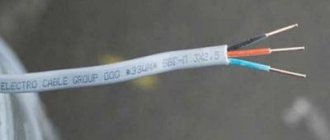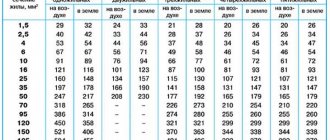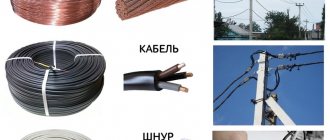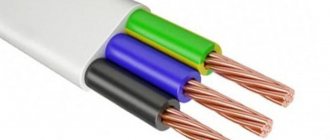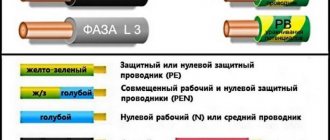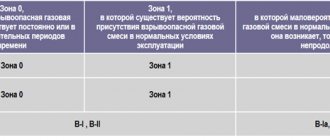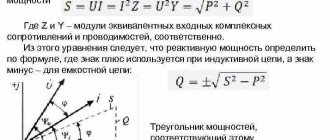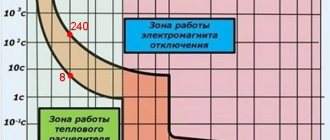The correct choice of electrical cable to power electrical equipment is the key to long-term and stable operation of installations. Using the wrong wire has serious negative consequences.
The physics of the process of damage to an electrical line due to the use of an unsuitable wire is as follows: due to the lack of space in the cable core for the free movement of electrons, the current density increases; this leads to excess energy release and an increase in the temperature of the metal. When the temperature gets too high, the line's insulating sheath melts, which can cause a fire.
To avoid trouble, you must use a cable with cores of suitable thickness. One way to determine the cross-sectional area of a cable is to start from the diameter of its cores.
Introduction
A cable is a wire covered with insulation that serves to transmit electricity from a source to a consumer. Today's market is ready to offer customers many types of similar wires: aluminum, copper, single-core, multi-core, single- and double-insulated, with a cross-section from 0.35 mm2 to 25 mm2 or more. But most often, to connect household consumers, cables with a thickness of 0.5 to 6 square meters are used - this is quite enough to power any equipment.
Classic cable for wiring in an apartment
Why is it necessary to select insulated conductors, and not buy the first one you come across? The thing is that the thickness of the conductor determines the current strength it can withstand. For example, the permissible current for copper wires 1 mm thick is up to 8 Amperes, aluminum – up to 6 Amps.
Why not just buy the thickest wire possible? Because the thicker it is, the more expensive it is. In addition, a thick cable needs to be hidden somewhere, a groove must be cut for it in the ceiling and walls, and holes must be made in the partitions. In a word, there is no point in overpaying, because you won’t be driving a KAMAZ to buy bread.
If you choose a wire with a smaller diameter, it simply cannot withstand the current passing through it and will begin to heat up. This leads to insulation melting, short circuit and fire. Therefore, you should never rush when choosing a high-quality cable for connecting any devices - first think about what exactly will work on the new line, and then choose the thickness and type of cable.
Application of cable 6 sq. mm
In the modern market of cable and wire products, the following brands of 6 mm2 cable are most in demand:
- NYM is a copper electrical cable with non-flammable polyvinyl chloride outer and individual insulation, meeting European standards and containing coated rubber as a filler. Its high quality workmanship, increased strength and heat resistance ensure high reliability of use.
- VVG-ng is a non-flammable power cable of 6 squares with single or multi-wire conductors, in a PVC sheath. Its variety VVG-ng LS, even when melted, does not emit harmful substances or smoke into the environment.
- VVbShv - armored cable with multi- or single-wire conductors for laying in the ground or in the open air. Its aluminum analogue AVBShv is less resistant to external factors, but can also be used to supply electricity to objects.
- PV-1 and PV-3 are flexible wires resistant to vibration and mechanical damage, widely used for the installation of lighting and power systems, distribution boards.
- PVC is a 6-square wire with increased flexibility, the outer PVC sheath of which fills the space between the insulated conductors. Used to connect household appliances and organize lighting.
- KG is an electrical cable with flexible conductors in rubber insulation, used for switching portable devices outdoors and indoors to the electrical network.
We can also supply PPG-ng HF. This is a flame-retardant 6 mm2 cable, even when laid in bundles, and does not emit thick smoke when heated to extreme temperatures. It is used at any facilities with an increased fire hazard, where there are large crowds of people or expensive equipment, including nuclear power plants.
How to calculate the power of devices
First, let's look at the option of choosing a cable cross-section based on the power of the devices connected to it. How to count correctly?
Think about which devices will be powered by a particular cable. If you pull it into the hall, then a TV, computer, vacuum cleaner, audio system, set-top box, hair dryer, floor lamp, aquarium lighting or other household appliances can simultaneously operate from the outlet in the room. Add up the power of all these devices and multiply the resulting value by 0.8 to get the real figure. Indeed, it is unlikely that you will use them all at the same time, so 0.8 is a reduction factor that will allow you to adequately estimate the total load.
If you are counting for the kitchen, then add up the power of an electric kettle, electric oven and hob, microwave, dishwasher, toaster, bread maker and other available/planned appliances. The kitchen usually consumes the most energy, so it should have either two cables with separate circuit breakers, or one powerful one.
So, to calculate the total power of all devices, you need to use the formula Ptotal = (P1+P2+...+Pn)*0.8, where P is the power of a specific consumer connected to the outlet.
Copper wires are better for wiring and can withstand greater loads
Application of measuring instruments
To determine the diameter of the cores of wires and cables, various measuring instruments are widely used, showing the most accurate results. Basically, the use of micrometers and calipers is practiced for these purposes. Despite their high efficiency, a significant drawback of these devices is their high cost, which is of great importance if the tool is planned to be used only 1-2 times.
As a rule, professional electricians who are constantly engaged in electrical installation work use special devices. With the right approach, it becomes possible to measure the diameter of wire cores even on working lines. After obtaining the necessary data, all that remains is to use a special formula: The result of the calculation will be the area of the circle, which is the cross-section of the wire or cable core.
Choosing thickness
Once you have determined the power, you can select the cable thickness. Below we will provide a table of wire cross-sections by power and current for a classic copper wire, since aluminum wires are no longer used for wiring today.
| Cable cross-section, mm | For 220 V | For 380 V | ||
| current, A | power, kWt | current, A | power, kWt | |
| 1,5 | until 17 | 4 | 16 | 10 |
| 2,5 | 26 | 5,5 | 25 | 16 |
| 4 | 37 | 8,2 | 30 | 20 |
| 6 | 45 | 10 | 40 | 25 |
| 10 | 68 | 15 | 50 | 32 |
| 16 | 85 | 18 | 75 | 48 |
Attention:
When choosing, keep in mind that most Russian manufacturers save on material, and a 4 mm2 cable may actually end up being 2.5 mm2. Practice shows that such “savings” can reach 40%, so be sure to either measure the cable diameter yourself or purchase it with a reserve.
Now let's look at an example of calculating the wire cross-section based on power consumption. So, we have an abstract kitchen, the power of the appliances is 6 kW. We multiply this figure 6*0.8=4.8 kW. The apartment uses one phase, 220 volts. The closest value (you can only take it as a plus) is 5.5 kW, that is, a cable 2.5 square meters thick. Just in case, we have a reserve of 0.7 kW, which “smoothes out” the savings for producers.
It should also be borne in mind that if the wire is working at its limit, it will heat up quickly. Due to heating to 60-80 degrees, the maximum current is reduced by 10-20 percent, which leads to overload and short circuit. Therefore, for critical sections of the chain, an increased coefficient should be used, multiplying the value not by 0.8, but by 1.2-1.3.
Correct calculation of cable thickness is the key to its long service life
Most often, copper structures with a thickness of 1.5 squares are used for laying lighting systems, for sockets - 2.5 squares, for powerful consumers - 4 or 6 squares (machines are installed at 16, 25, 35 and 45A, respectively). But this use is only suitable for standard apartments or houses that do not have powerful consumers. If you have an electric boiler, boiler, oven or other appliances that consume more than 4 kW, then you need to calculate the cables for each specific case, and not use general recommendations.
The above table of cable cross-sections for power and current uses limit values, so if you get calculated numbers that overlap with encyclopedic ones, then try to take the cable with a reserve. For example, if our kitchen had a power of 7 kW, then 7 * 0.8 = 5.6 kW, which is greater than the value of 5.5 for a 2.5 square cable. Take a cable of 4 squares with a reserve or divide the kitchen into two zones by connecting two 2.5 mm2 cables.
Cable 6 squares – range, delivery, benefits
The online store “World of Electrics” has been selling a huge range of electrical goods for more than 15 years. A wide selection allows you to immediately select the desired 6 kV cable. mm, both made in accordance with GOST and the factories’ own technical specifications, or order an electrical cable of 6 squares of rare brands with guaranteed delivery to the warehouse within 1–3 days.
You can buy a cable at the best price per meter with additional discounts and receive it within 24 hours from World of Electrics. We quickly process applications and send goods for delivery throughout the capital and region today if the order is received before noon. A polite courier service driver will deliver the order and provide comprehensive information about the features of operation and installation. It is also possible to send products by logistics companies in Moscow, Moscow Region and to the regions.
What to do with the length
If you are counting cables in an apartment or small house, then you don’t have to make any adjustments to the cable length at all - it’s unlikely that you will have branches 100 meters or more in length. But if you are laying wiring in a large multi-story cottage or shopping center, then you must take into account possible losses along the length. Usually they are 5 percent, but it is more correct to calculate them using a table and formulas.
So, the load moment is calculated as the product of the length of your wire and the total power consumption. That is, the length of your cable is calculated as the product of the cable length in meters and the power in kilowatts.
In the table below we see how losses depend on the cross-section of the conductor. For example, a cable with a thickness of 2.5 mm2 with a load of up to 3 kW and a length of 30 meters has a loss of 30x3 = 90, that is, 3%. If the loss level exceeds 5%, then it is recommended to choose a thicker cable - there is no need to skimp on your safety.
| U, % | Load moment, kW*m | |||||
| 1,5 | 2,5 | 4 | 6 | 10 | 16 | |
| 1 | 18 | 30 | 48 | 72 | 120 | 192 |
| 2 | 36 | 60 | 96 | 144 | 240 | 384 |
| 3 | 54 | 90 | 144 | 216 | 360 | 575 |
| 4 | 72 | 120 | 192 | 288 | 480 | 768 |
| 5 | 90 | 150 | 240 | 360 | 600 | 960 |
This table of loads by cable cross-section is valid for a single-phase network. Three-phase is characterized by an average increase in load size of six times. The value increases three times due to distribution over three phases, and two times due to the neutral conductor. If the load on the phases is uneven (there are strong distortions), then losses and loads increase greatly.
Correct connection of machines with copper cable
You should also consider which consumers will be connected to your wire. If you plan to connect halogen low-voltage lamps, then try to place them as close to the transformers as possible. Why? Because if the voltage drops by 3 volts at 220 volts, we simply won’t notice, and if the voltage drops by the same 3 volts at 12 volts, the lamps simply won’t light up.
If you select the wire cross-section according to the current for an aluminum cable, then keep in mind that the resistance of the material is 1.7 times higher than that of copper. Accordingly, losses in them will be greater by the same 1.7 times.
Defining a section using a ruler
An economical and accurate method is to determine the cross-section of cables and wires using an ordinary ruler. In addition to this, you will need a simple pencil and the wire itself. To do this, the wire core is stripped of insulation and then tightly wound onto a pencil. After this, the total length of the winding is measured using a ruler.
The resulting measurement result must be divided by the number of turns. The result is the diameter of the wire, which will be needed for subsequent calculations. The cable cross-section is determined by the previous formula. To obtain more accurate results, there should be as many wound turns as possible, but not less than 15. The turns are pressed tightly together, since free space contributes to a significant increase in the error in calculations. The error can be reduced by using a large number of measurements taken in different versions.
